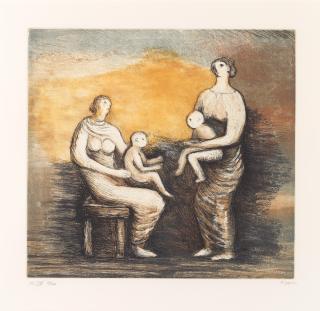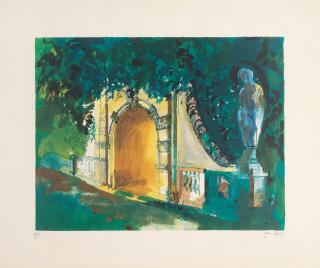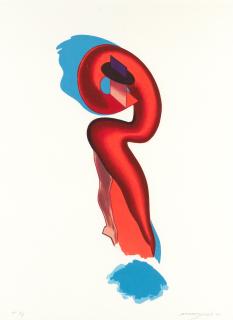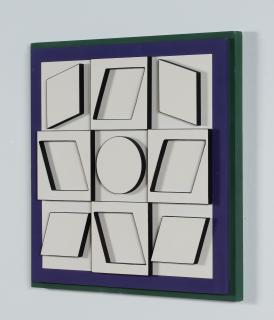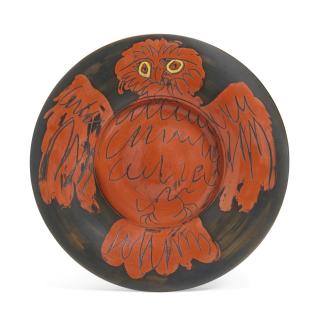Bruce McLean born 1944 in Glasgow
The artist Bruce McLean
- Scottish performance artist, painter and sculptor with a penchant for parody.
- Rebelled against conventional art forms even in his student days.
- Made fun of the »pretensions of the art world« with a one-day retrospective in 1972.
Bruce McLean is a Scottish performance artist, painter and sculptor. He never made a secret of wanting to stand out - he was always »against it.« McLean was born in Glasgow, Scotland in 1944, attended the Glasgow School of Art between 1961 and 1963 and St Martin's School of Art in London from 1963 to 1966. He, along with others, rebelled against the »academic formalism« of the teaching staff. What he thought of the mainstream views of art, he let everyone know. In the end, it was his parodic view of conventions that made him famous.
It started in 1965, when he said goodbye to the usual studio production and turned to the »imperishable« sculptures, incorporated water and began his legendary performances. From the beginning, they stood out for their satirical character. In the performance Pose Work for Plinths I (1971; London, Tate), for example, he posed himself as the reclining figures of Henry Moore.
In 1972, the Tate Gallery offered him a solo show: McLean chose the form of the »retrospective,« which was to last only one day. In the 1970s, the performance artist was on the faculty of the former Maidstone College of Art (Kent, England). During this time, he teamed up with others to form the troupe Nice Style, which ironically acted as the World's First Pose Band. Their collective performances took the »pretensions of the art world« as well as social and political issues for a ride.
Beginning in the mid-1970s, painting entered McLean's previously performance-oriented oeuvre. However, his subversive-satirical style did not have to give way to the new technique. He continued to flirt with parodic interpretations of Expressionism or ceramics. McLean succeeded in participating in documenta 6, 7, and 8, as well as in a wide variety of solo shows. One of his most recent solo exhibitions was held by the Kunsthaus Graz in 2014. The unusual artist won prizes from the 1960s to the 1990s. In 1985, for example, he received the John Moores Painting Prize, and in 1994 the Royal Television Society honored him with a Design Award for Production Design in the field of non-drama.
Der Künstler Bruce McLean
- Schottischer Performancekünstler, Maler und Plastiker mit Hang zur Parodie.
- Lehnte sich schon zu Studienzeiten gegen konventionelle Kunstformen auf.
- Machte sich 1972 mit einer eintägigen Retrospektive über Kunstkonventionen lustig.
Bruce McLean ist ein schottischer Performancekünstler, Maler und Plastiker. Er machte nie einen Hehl daraus, auffallen zu wollen – er war immer »dagegen«. McLean kam 1944 in Glasgow, Schottland, zur Welt, besuchte zwischen 1961 und 1963 die Glasgow School of Art und von 1963 bis 1966 die St Martin's School of Art in London. Er lehnte sich zusammen mit anderen gegen den »akademischen Formalismus« des Lehrpersonals auf. Was er von den gängigen Ansichten der Kunst hielt, ließ er alle wissen. Schließlich war es seine parodistische Sicht auf Konventionen, die ihn berühmt machte.
Los ging es damit ab 1965. Er verabschiedete sich von der üblichen Atelierproduktion und wandte sich den »unvergänglichen« Skulpturen zu, arbeitete Wasser mit ein und begann mit seinen legendären Performances. Von Beginn an fielen sie durch ihren satirischen Charakter auf. Bei der Performance Pose Work for Plinths I (1971; London, Tate) etwa posierte er selbst als die liegenden Figuren von Henry Moore.
1972 bot ihm die Tate Gallery eine Soloschau an: McLean wählte die Form der »Retrospektive«, die nur einen Tag andauern sollte. In den 70er Jahren war der Performance-Künstler am Lehrstuhl des ehemaligen Maidstone College of Art (Kent, England) tätig. In dieser Zeit tat er sich mit anderen zur Truppe Nice Style zusammen, die ironisch als World's First Pose Band agierte. Ihre gemeinsamen Performances nahmen sowohl die »Anmaßungen der Kunstwelt« als auch gesellschaftliche und politische Themen auf die Schippe.
Seit der Mitte der 1970er Jahre kehrte die Malerei in das bis dahin performance-orientierte Œvre McLeans ein. Der neuen Technik musste sein subversiv-satirischer Stil aber nicht weichen. Er kokettierte weiterhin mit parodischen Interpretationen des Expressionismus oder der Keramik. McLean gelang die Teilnahme an der documenta 6, 7 und 8 sowie verschiedenste Soloschauen. Eine seiner jüngsten Einzelausstellungen veranstaltete das Kunsthaus Graz 2014. Preise gewann der ungewöhnliche Künstler von den 1960ern bis in die 90er. 1985 erhielt er beispielsweise den John Moores Painting Prize, 1994 zeichnete ihn die Royal Television Society mit einem Design Award for Production Design im Bereich Non-Drama aus.
Bruce McLean in a nutshell
Bruce McLean's best-known paintings include Hot Slick (1989) and Large Warhead (1984), and his more recent works Healing Garden (2010) and Designer Trees (2011).
Pose Work for Plinths was originally a performance that McLean premiered at Situation Gallery in 1971. Today, Pose Work for Plinths is a series of three photographs documenting the performance. McLean posed dressed in black on white plinths in response to Henry Moore's large plinth-mounted sculptures. It was his ironic and humorous response to Moore's »pompous monumentality«. The performances Pose Work for Plinths I - III including the documented photo series is one of his most famous works ever.
Häufige Fragen zu Bruce McLean
Zu Bruce McLeans bekanntesten Gemälden zählen Hot Slick (1989) und Large Warhead (1984) sowie seine neueren Werke Healing Garden (2010) und Designer Trees (2011).
Hinter Pose Work for Plinths verbirgt sich ursprünglich eine Performance, die McLean in der Situation Gallery 1971 uraufgeführt hat. Heute versteht man unter Pose Work for Plinths eine Reihe von drei Fotografien, die die Perfomance dokumentieren. McLean posierte schwarz bekleidet auf weißen Sockeln als Reaktion auf Henry Moores große, auf Sockeln stehende Skulpturen. Es war seine ironische und humorvolle Antwort auf Moores »pompöse Monumentalität«. Die Performances Pose Work for Plinths I – III inklusive der dokumentierten Fotoreihe ist eines seiner bekanntesten Werke überhaupt.






























